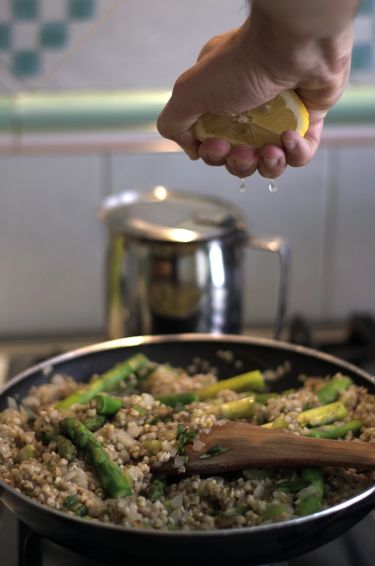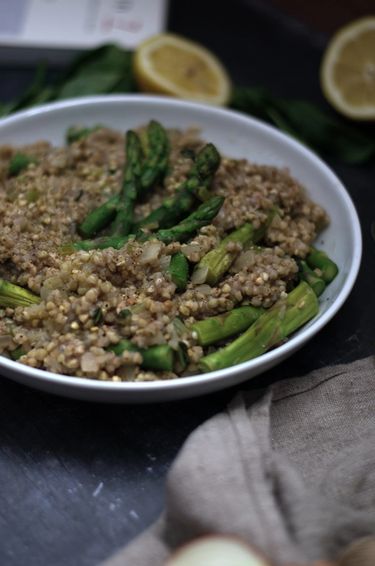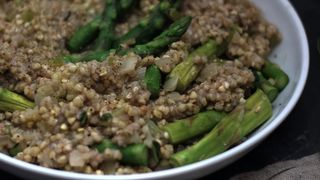If you enjoy this article, or any other content from this website, please subscribe to the newsletter. Your support can make a big difference!
It's asparagus season and with that, I also took the opportunity to have a go at sourcing wild asparagus in Malta a few weeks ago. It turned out to be a wonderful walk in the countryside but we returned to the finish line empty-handed — that is until we hit the car park, where there happened to be a couple of lonely wild asparagus waiting for us all along. Didn't we feel silly!
Now that asparagus is gracing the vegetable stalls, I couldn't help but dig in. The thing is I'm still in the awkward-handling phase with this vegetable. I don't typically do much other than cook it as a side dish.
I took to my recipe books for inspiration and decided to pick out a recipe from Vegan in 7 by Rita Serrano. Her dish, which is buckwheat risotto with asparagus only includes 7 ingredients but can be spruced up to suit anybody's taste.
What is Buckwheat?
Raw buckwheat deceptively looks like a grain. And its name 'buckwheat' alludes to it being a wheat grain. Well, it turns out, it’s not even a grain. It is actually related to rhubarb and sorrel.
Buckwheat is a highly nutritious whole fruit seed that many people consider to be a superfood. Among its health benefits, buckwheat may improve heart health, promote weight loss, and help manage diabetes. Buckwheat is also a good source of protein, fiber, and energy. It actually contains more protein than rice and has higher essential amino acids.

Is buckwheat gluten-free?
Because it is neither a grain nor related to wheat, buckwheat is gluten-free and safe for those with celiac disease and gluten sensitivities. Studies show that even in high concentrations, buckwheat flour and its purified proteins have no immunologic reactions for patients with celiac disease.

Making a Risotto out of Buckwheat
Risotto is made of arborio rice which is a type of rice grain that takes well to liquid, gradually absorbing it. Not too differently, buckwheat swells up once the liquid is applied. Most commonly it is used to make buckwheat porridge, a staple in Eastern European households.
This 'risotto' dish is simple in that you don't actually have to keep added stock at intervals but I do recommend that you stir it every so often as it cooks to ensure that all the grains are coated and exposed to the stock.
I stuck to Rita Serrano's recipe but I added lemon juice to brighten the dish. You could also add wine (and reduce the amount of stock in proportion) to add more acidity. When I make it again, I also intend to add English peas (obsessed with them if you've read my earlier post about making a spring pasta or 'primavera' pasta.)

Buckwheat Risotto with Asparagus and Lemon
No reviews yet
Description
A delicious 8 ingredient buckwheat 'risotto' with seasonal spring asparagus
Information
- Servings
- 2portions
- Preparation time
- 10minutes
- Cooking time
- 20minutes
Ingredients
- 250grasparagus, hard ends of spears discarded
- 200grbuckwheat, washed and drained
- 750mlvegetable stock (or water)
- —half a large lemon, juiced
- —handful of fresh basil, chopped
- —celery stalk, finely chopped
- —half a medium onion, finely chopped
- —salt and pepper, to taste
Method
1. Prepare the ingredients
Finely chop the celery stalk and onion. Heat up a large pan with a tablespoon of olive oil over medium heat. Once the oil is hot, add the chopped celery and onion, with a splash of water, and cook until translucent, 5-10 minutes.
2. Prepare the stock
Prepare and heat up the vegetable stock. I used an organic vegetable cube and added to 750ml of water.
Remember that if you choose to add wine, reduce the corresponding quantity of stock as you don't want to add too much liquid to the buckwheat.
3. Cook the buckwheat
Add the buckwheat to the pan with the cooked celery and onion and add all the stock. Bring to a boil and then reduce to a simmer for 20-25 minutes, stirring every so often. The buckwheat will swell and turn creamy.
4. Blanche the asparagus
Trim the end of the asparagus and chop these. A trick to know where to cut the ends is to bend the bottom but of the asparagus. Where it snaps is where you need to cut to remove the woody stalk.
Once the ends are off, cut the asparagus into fourths and then add them to a pot of salted boiling water, Blanche for two minutes, and drain.
5. Add the final ingredients and serve
When the buckwheat is soft and creamy, add in the asparagus. Also, add the squeezed lemon and chopped basil and mix thoroughly. Add salt and pepper to taste and serve immediately.

